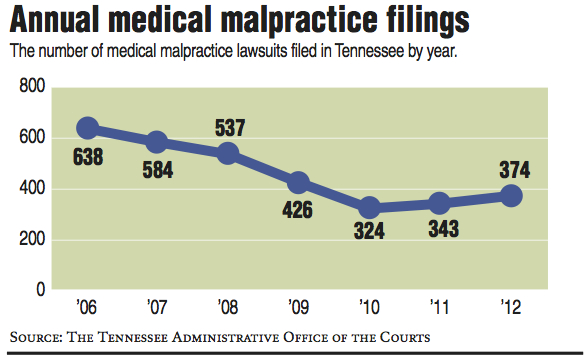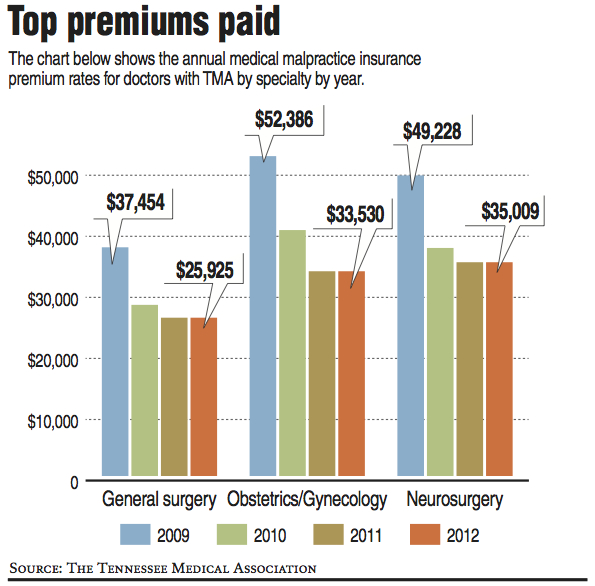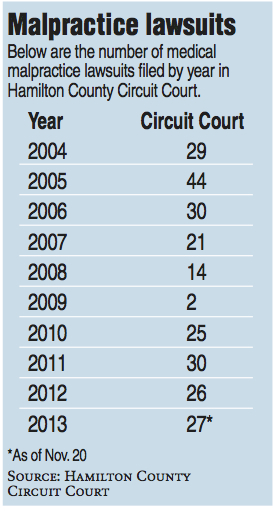Medical malpractice suits drop in Tennessee; 2008 reforms praised, panned
Tuesday, December 3, 2013
The number of medical malpractice lawsuits filed in Tennessee each year has fallen by 36 percent since reforms went into effect five years ago.
The state's leading doctors organization says this is evidence of a long-needed change that helps patients get access to medical care.
But Tennessee's top plaintiffs' lawyers association says the change has made it nearly impossible to hold negligent doctors accountable.
In 2007, the year before changes to medical malpractice filing, lawyers filed 584 such suits, compared to 374 last year.
Tennessee Medical Association President Dr. Chris Young said the 2008 reform is one of the most effective things TMA has done for doctors. He called the legal climate before the changes, "liability gone wild."
He hopes the reforms have cleared out frivolous lawsuits and left more time for the courts to focus on legitimate medical malpractice claims.
But the head of the Tennessee Association for Justice, a plaintiffs' lawyers group, says the new legal landscape favors doctors at the expense of injured patients.
"What people in Tennessee don't understand is there has been an effort to take away their rights to access the courthouse," said association President Bryan Smith.
Smith and other lawyers who have handled medical malpractice cases said caps to damages enacted by the state Legislature, and a more stringent certifying process before a lawsuit can be filed, have made these already complicated and expensive cases too risky for most lawyers to attempt. The process also requires plaintiffs to notify the defendant 60 days before filing the lawsuit. The entire lawsuit can be thrown out for even minor errors in filing.
This is different than almost any other type of tort lawsuit in the Tennessee legal system, lawyers said.
Nearly half of the 50 states have passed some type of cap on noneconomic damages in medical malpractice lawsuits. Sixteen states have passed such caps since 2000, with the basic caps ranging from $250,000 to $750,000, according to a 2013 report conducted by the American Medical Association using data available in 2011.
Noneconomic damages are considered more subjective claims such as "pain and suffering" or "loss of enjoyment of life." Economic damages are more measurable items such as loss of income, future earnings, past and ongoing medical bills.
Tennessee's cap, of $750,000 would fall at the higher end, based on the AMA report.
Miller and Young both said years of pushing for medical malpractice reform came out of rising insurance rates and fears that Tennessee would lose doctors or fail to recruit them, largely due to the malpractice environment.
But multiple attorneys interviewed, including Smith and local attorney Chris Clem, said there had been no episodes of "runaway juries" awarding hefty dollar amounts in malpractice cases and that the doctors had no cause for alarm.
"Quite frankly, we've gotten out of medical malpractice altogether," said local attorney Jay Kennamer.
The certifying process essentially requires an attorney to prove he already has gotten experts to evaluate his client's claim and agree that the health care provider harmed the patient. Further reforms in 2011 capped damages in such cases.
"For all intents and purposes the health care community is immune from simple negligence," said local attorney Sam Jones. "Unless there is egregious negligence and long-term damages, it's not economically viable to take one of these cases."
An article in the October issue of Tennessee Bar Journal by attorney Clinton Kelly notes that 80 percent of all medical malpractice lawsuits are won by the health care provider.
Kelly listed some of the costs involved: Medical experts may cost from $500 to $1,000 an hour, trial preparation could total $50,000 to $100,000 and the trial itself could cost $25,000 to $50,000.
"Most plaintiff lawyers will not risk losing $100,000 in litigation costs against a $750,000 maximum recovery when the defendant's rate of victory at trial is nearly 80 percent," Kelly wrote.
But another medical association representative finds lawyers' claims questionable.
"The fact that some people can't access the system because they don't have means seems like a problem for the legal industry," said Russ Miller, TMA's CEO.
"It's still not a perfect system," Miller said. "People have to be liable for their negligent actions. I think we have a fair system now."
Miller points to another number as evidence that the more frivolous or unnecessary cases have been filtered out -- time.
The 2013 Tennessee Trial Courts Judicial Weighted Caseload Study showed that though the number of medical malpractice lawsuits filed each year was down, the amount of time judges spend on them has doubled.
Miller said this is time spent on necessary malpractice cases, which are complex and lengthy.
In the previous major caseload study, conducted in 2007, judges estimated that they spent 11 hours on a medical malpractice lawsuit. The 2013 study shows judges estimating that they spend 22 hours on those lawsuits.
That is the most time spent, by far, on any type of court case. The next closest case in average time is a first-degree murder case, which judges listed at 13 hours in the most recent study.
The decrease in medical malpractice lawsuits has had a sustained effect for doctors, Miller said. In every specialty listed by the TMA on a recent report, insurance premium rates have dropped since 2009.
In the higher-risk specialties such as obstetrics, general surgery and neurosurgery, that has meant a savings of between $11,500 and $18,856 annually.
"Lawsuits are the catalyst for rates; if there's no suit, then there's no cost," Miller said.
Even though doctors overwhelmingly win when sued, the cost of defending such lawsuits is high, Miller said.
"They can be sued out of business tomorrow," Miller said.
There has not been any wholesale recruiting of doctors to Tennessee, Miller said, but having more protection and lower insurance rates makes the state more attractive to physicians.
And if plaintiffs' lawyers begin winning, lawsuit rates could again rise. Doctors have little room to shift costs, Miller said.
The same TMA report notes that trial lawyers "have every intention to reverse these reforms."
But Smith said any change is unlikely in the current, Republican-dominated state Legislature.
"There's not a lot we can do about it given the political environment," Smith said.
Kennamer said there was no need for reform in the first place since few plaintiffs won at trial and most cases were settled.
"This was overreaction in Nashville," he said. "This was all the hangover from the George Bush years. They're so far right they'll do anything they can to hurt plaintiffs' attorneys."
Yet Miller worries that threats to the long-fought, TMA-backed reforms could come from outside the Legislature.
So far appeals have favored the reformed medical malpractice requirements, but Miller said nothing with law is permanent. The law is always just one case away from being reversed.
He pointed to reforms in Georgia that capped noneconomic damages in medical malpractice cases at $350,000, nearly half of Tennessee's cap. The Georgia caps were deemed unconstitutional by the Supreme Court of Georgia in a ruling on a 2010 lawsuit.
The Georgia justices wrote, "The very existence of the caps, in any amount, is violative of the right to trial by jury."
The cases may be fewer in number, but they are still filed.
Clem filed a $25 million suit in Hamilton County Circuit Court in November.
The suit, filed on behalf of Bennie Gilstrap III, alleges that while at HealthSouth Chattanooga Rehabilitation Hospital, nurses failed to rotate or move him and treat and care for pressure ulcers that formed on his ankle, heel, foot and buttocks.
The ulcers ate away enough muscle in Gilstrap's legs that he'll need lifelong assistance to walk, Clem said.
The multimillion-dollar request is rare, Clem said. He was able to file the lawsuit requesting the high amount because he alleges there is evidence caretakers with HealthSouth changed paperwork to try to cover up that they had not properly cared for Gilstrap.
If proven, the alleged cover-up triggers an exemption from the caps, Clem said.
Clem admits that had a doctor not contacted him about Gilstrap's condition, he wouldn't have taken the case.
"I had to really think twice before I take a claim like this," he said.
The amount of money and time and likely strong resistance he'll face from HealthSouth attorneys means he'll spend as much as half of his work time over the next two years on the case, with no guarantee of anything to show for it if he loses.
Contact staff writer Todd South at tsouth@timesfreepress.com or 423-757-6347. Follow him on Twitter@tsouthCTFP.



